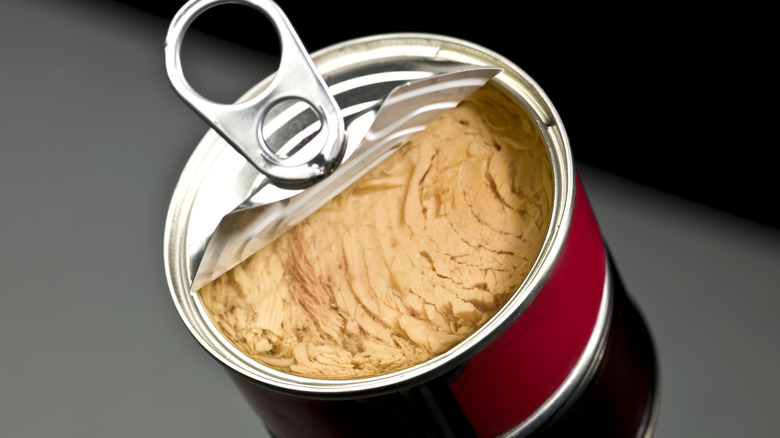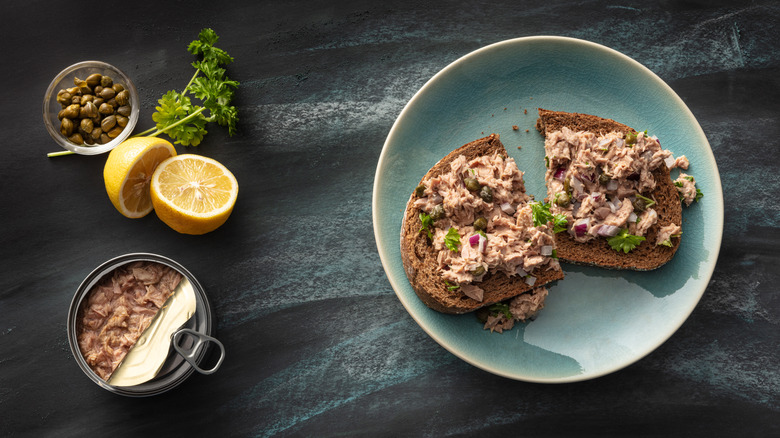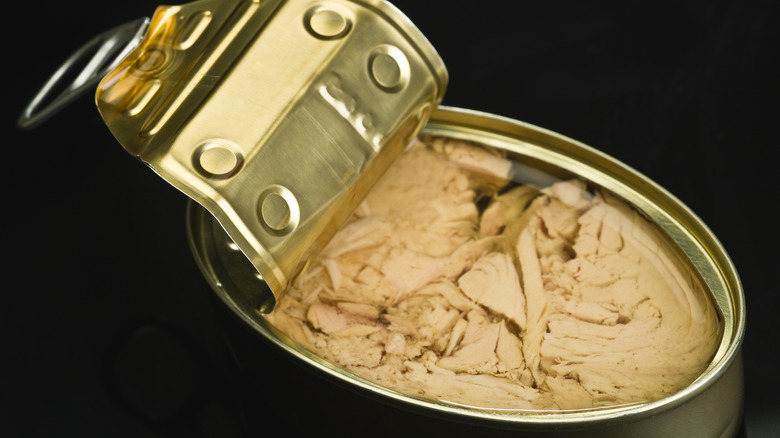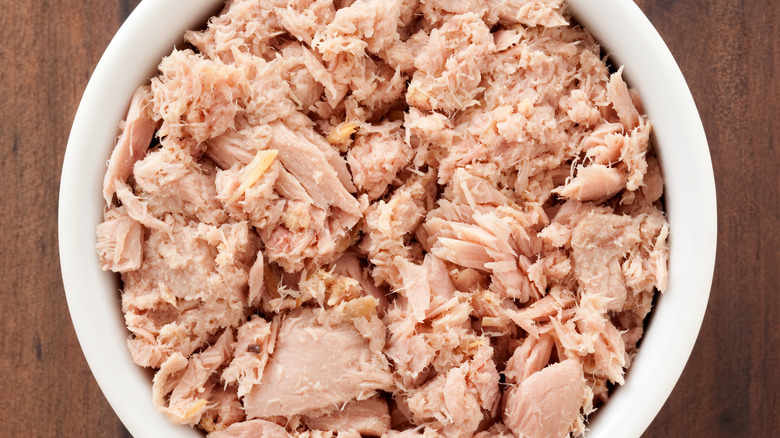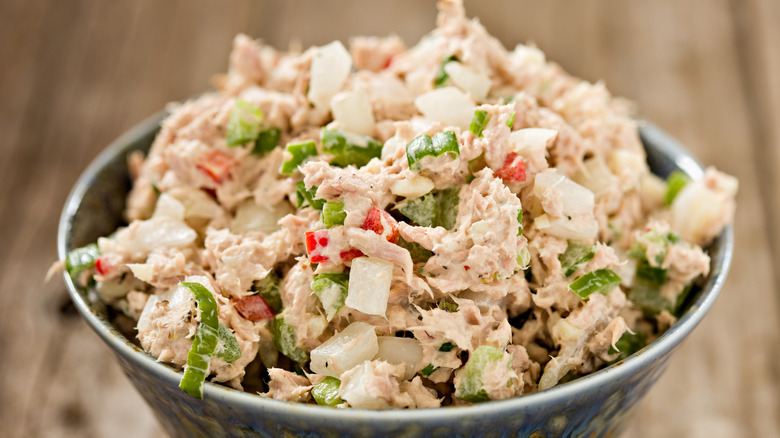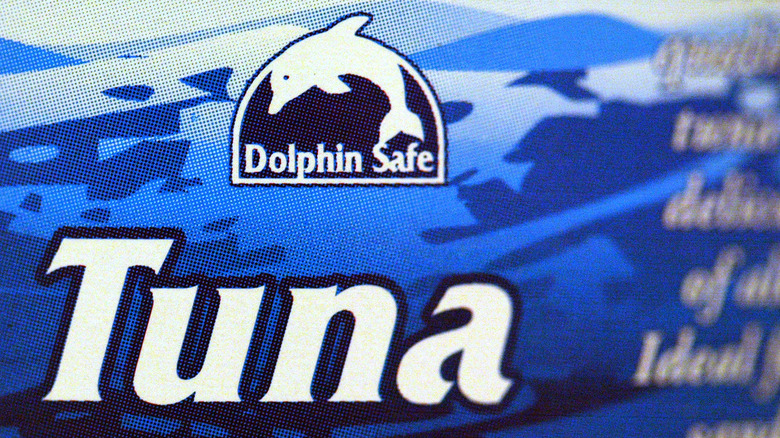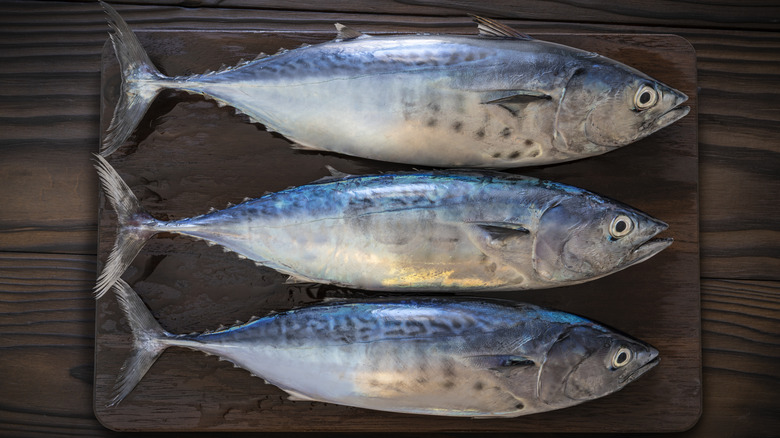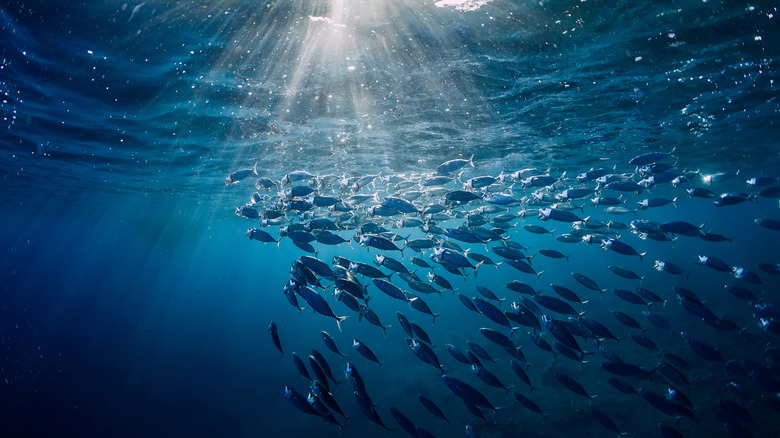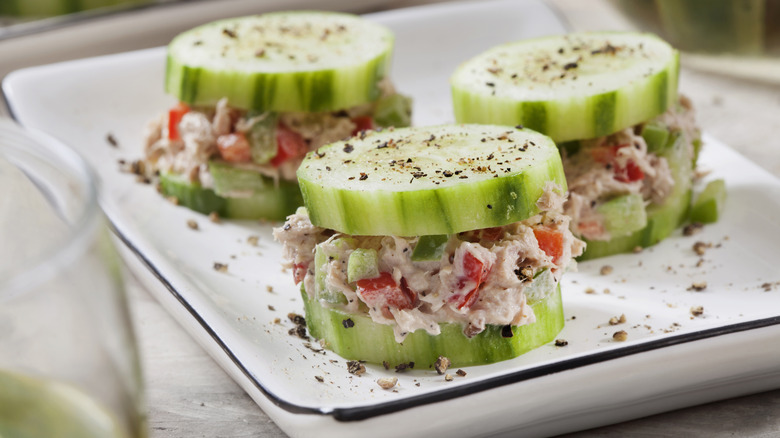Canned Tuna Myths Exposed By Fish Experts
It's no secret that fish brings all kinds of invaluable goodness to the plate and is part of a well-rounded diet. While there might be nothing quite like a delicious swordfish steak or some fresh salmon, it's also true that not all of us are lucky enough to live in a place where it takes just a hop, skip, and a jump for fish to get from the water to our plate.
That leaves many of us to opt for frozen or canned fish. If the mere mention of canned tuna was enough to make you cringe, that's completely understandable. It wasn't that long ago that the main uses for canned tuna were a tuna salad sandwich (on white bread, of course) or that infamous classic, tuna noodle casserole. Canned tuna had a weird texture, a fishy smell that lingered, and it wasn't that great, right? Thankfully, there's good news: That's not the case anymore, and not only is canned tuna high-quality, but it's pretty delicious.
There are a ton of amazing recipes that use this ingredient, so let's debunk some oft-repeated rumors about canned tuna. If you've heard horror stories about mercury content, sky-high sodium levels, or rumors that the fish going into the can just isn't as good as the fresh stuff, it's time to take a step back and reconsider. We reached out to some experts to help us set the record straight on canned tuna.
Myth: Canned tuna is dangerously high in mercury
Concerns over the mercury content in fish have been swirling for a long time, with some types like swordfish being notoriously high in mercury. Exposure to mercury comes with serious consequences, and while there are rumors that canned tuna can be high in mercury, the experts we reached out to say that's just not the case.
Rima Kleiner, a registered and licensed dietician and nutritionist at Dish on Fish, told us that worries about mercury in canned tuna is something she hears often, but clarifies: "Contrary to misconceptions that continue to persist, canned and pouched tuna is not high in mercury. All the different kinds ... fall well below the FDA safety limit. In fact, after analyzing more than 100 scientific studies on seafood, the FDA summarized that the average person could eat tuna for breakfast, lunch, and dinner every day of the week without worry."
She says that all types of tuna commonly used in canned tuna are safe, but what about those who want to play it extra-safe? Rachel MacPherson, CSCS, a certified exercise nutritionist with Bodybuilding Reviews, told us that while the average can of albacore tuna is well below FDA regulations, "Light skipjack tuna has far less mercury than albacore." Dr. Kubanych Takyrbashev, a health and wellness Advisor at NAO agees, telling us: "Generally, smaller tuna species like skipjack and light canned tuna tend to have lower mercury levels than larger species like albacore or white tuna."
Myth: Canned tuna lacks omega 3-fatty acids
Omega-3 fatty acids are referenced quite a lot in the food world, but their importance isn't exaggerated. A ton of scientific studies have shown they're crucial for cardiovascular health, can reduce inflammation, and have also been linked to alleviating issues associated with issues like asthma and ADHD. Fish is a major source of omega-3 fatty acids, but canned tuna is often overlooked as a viable and convenient source. It absolutely shouldn't be, as our experts confirmed.
As Kleiner told us, "When it comes to omega-3 fatty acids, you can't go wrong with fresh or canned tuna. Both are great options for getting in more omega-3 fatty acids DHA and EPA, which are important for optimal brain, heart, skin, and immune health."
MacPherson agrees and shares an important caveat with us. She says that although canned tuna in any form is a great source of omega-3 fatty acids, she also adds that if you plan on draining it before use, water-packed tuna is the way to go. Why? "When you drain tuna packed in water, the omega-3s contained in this oily fish are largely retained. But when you drain tuna packed in oil, it drains some of those lovely omega-3 fats." Now you know!
Myth: When tuna is processed and canned, it loses nutrients
Dr. Kubanych Takyrbashev is a medical doctor and wellness advisor at NAO, and in his field of expertise, he gets a lot of questions about best practices. When we spoke with him about the differences between fresh and canned fish, he stressed that canned tuna is a wonderful option for getting important vitamins, minerals, and omega-3 fatty acids. He also said that one of the concerns he often hears is the idea that because the tuna has gone through the canning process, it might be less nutritionally valuable.
"Canned tuna is a popular and convenient food," he told us. "Despite this, people often doubt its nutritional value ... Regarding common misconceptions, one worth addressing, in my opinion, is the notion that all canned tuna is unhealthy due to concerns about additives or processing." Simply put, that's just not the case. Canned tuna, he says, is a great way to get some much-needed nutrition in a way that's convenient for today's busy schedules.
MacPherson agrees. She told us that although fresh fish can have things like protein and nutrients in a higher quantity than canned, that's no reason to skip the canned tuna — especially if it fits better into your lifestyle, schedule, and budget. "Canned fish is more convenient, has a longer shelf life, and is more affordable, so it's easier to fit into your diet," she says. For many, that makes it a win.
Myth: Additives mean canned tuna isn't a great option
For as long as canned food has been around, people have been a little suspicious of what's hiding inside. That's true of canned tuna as well, so it comes as little surprise to hear some say that canned tuna contains additives that make it a poor choice. According to what Takyrbashev told us, he frequently gets questions about whether or not foods like canned tuna should be avoided because of additives. The answer is complicated. It all comes down to something that many of us are probably already in the habit of doing — reading the label. Do that, and you'll find some good canned tuna options out there. "While choosing high-quality brands and checking labels for additives like excess sodium or added sugars is essential, canned tuna can be a nutritious and convenient protein source when included in a balanced diet," Takyrbashev says.
Kleiner agrees. She told us that canned tuna is an invaluable source of vitamins and nutrients and went on to provide some fascinating context. She said, "Most Americans eat far too little seafood to meet nutrient needs, and that eating too little contributes to 84,000 preventable deaths each year." That number is backed up by a 2009 study published in PLOS Medicine. One affordable, easy solution to get those numbers down? Canned tuna.
There you have it! Broadly speaking, canned tuna is no different from any other food when it comes to the importance of reading labels.
Myth: All canned tuna is dangerously high in sodium
While it's necessary to have a certain amount of sodium in our diets, having too much salt regularly can have dire consequences for both your short- and long-term health. The American Heart Association recommends that most adults consume no more than 2,300 mg of salt per day, but many Americans come in at around 1,000 mg more than that. Canned and processed foods are a big source of salt overconsumption, so does that mean all canned tuna is off the table for anyone who's watching their sodium intake? Not at all.
Kleiner told us that, while sodium is a crucial ingredient used in the preservation of shelf-stable foods, it's not all bad, especially compared to other fooods. "The amount of sodium in canned tuna is like the sodium in frozen raw chicken meat, and less than what's in a hamburger," she said. It's also "significantly lower than the sodium amounts in prepackaged and restaurant foods, and frozen meals."
Putting it in that context helps more than all the numbers in the world, right? Kleiner also says that there are a few things that customers can do if they wish to limit their sodium intake, stressing that low-sodium or no-salt-added cans of tuna are a legitimately good option. Grab the wrong ones while you were shopping? Don't worry! She says that rinsing the tuna before using it will remove some of the sodium content.
Myth: Dolphin-safe tuna is dolphin-safe
No one wants to think of dolphins becoming pointless casualties of the tuna harvest, so reaching for the can that says "dolphin-safe" might seem like a no-brainer. But here's the thing: Not only does it not mean what you think it means, it doesn't actually mean anything at all. Bart van Olphen is a sustainable fishing advocate, chef, founder of Sea Tales, and the author of "The Tinned Fish Cookbook," and he gave us the troubling truth behind that dolphin-safe label.
He explained: "Dolphin-safe fishing refers to limiting by-catch," or animals unintentionally caught while fishers are seeking a different species. He continued: "It's essentially a meaningless descriptor as it is not enforced, and is only one piece of sustainable tuna fishing practices."
So why on earth is it a thing? The dolphin-safe labels came about after 1980s activists tried to stop tuna fishermen who followed tuna-hunting dolphins. Their use of nets included dolphins as part of the unintended bycatch. That practice came to an end (mostly). Today, dolphin-safe essentially means that fishing captains promise to not intentionally catch dolphins, at least in the U.S. In other words, that label doesn't necessarily mean that no dolphins were harmed or killed in the fishing of tuna. In reality, the CATO Institute condemns so-called dolphin-safe brands as using some of the most unsustainable fishing practices out there. So, "dolphin-safe" is potentially a red flag that you should avoid.
Myth: All canned tuna is pretty much the same fish
Tuna is tuna ... right? Absolutely not, according to Kleiner. She explained that albacore and white tuna is popular because it has a meatier texture and a more mild taste than yellowfin or skipjack tuna, which is usually identified as "light tuna." That difference can be incredibly important. If someone in your family says they're not a fan of canned tuna, try a different species and see if they might change their mind.
Van Olphen has a ton of first-hand experience in the fishing industry from the ocean to the plate. He confirmed that there are quite a few differences between canned tuna varieties, given that albacore, yellowfin, and skipjack tuna have different tastes and textures.
He says that there's another very good reason to avoid albacore: overfishing. "[I]ts popularity as a food source has driven the population to 'near threatened' status," he says. "To take the pressure off albacore, we should buy and eat more skipjack tuna, the most abundant species of tuna in the oceans right now." He also adds that skipjack works especially well if you're planning on using it in a warm recipe.
Myth: Canned tuna is a no-go during pregnancy
Something often repeated on the internet is the idea that during pregnancy, some fish is good, some is bad, and some is fine in moderation. It's easy to see how something like canned tuna might make it on the no-go list for many pregnant people.
It's not that straightforward, though. We spoke with Aubrey Phelps, MS RDN CLC, a registered dietician and lactation counselor at the Maven Clinic, who specializes in perinatal nutrition and fitness. As she explained, "Tuna during pregnancy is generally considered safe for up to about 5 oz. per week: Fresh, canned, either!" That's great news for tuna lovers. For anyone who's still concerned, she added that some companies go above and beyond federal recommendations for testing fish. "There are also certain companies like Safe Catch that both focuses on sustainability, and does their own testing and standards for mercury, which are stricter than the FDA's mercury action limit."
What about concerns over sodium in canned fish during pregnancy? Phelps says that while she advises monitoring sodium intake from highly processed foods, "Sodium from fish that live in salt water? Absolutely not something I would worry about!" On the contrary, there are plenty of good things in canned tuna. "The protein, DHA, iodine, selenium, and more is absolutely necessary for pregnancy and often woefully inadequate," Phelps says. "So if you can manage that best through some tuna each week, go for it!"
Myth: Canned tuna isn't sustainable
There's a lot of baggage that goes along with canned products, particularly when it comes to sourcing and quality. While it might seem that canned tuna is likely made with fish caught in a less-sustainable way than fresh fish, that's not necessarily the case, according to van Olphen.
Van Olphen told us that there are some very sustainable options out there when it comes to canned tuna. How do you know you're buying them? He says that the Marine Stewardship Council (MSC) label is the most important thing you can look for. This label means "You can be assured it's being fished using methods that aren't depleting the oceans. MSC tuna encourages more ocean-friendly fishing practices, so when you see the MSC blue fish label on cans, you know that it's sustainably sourced, from a fully traceable supply chain, and wild-caught."
Securing the future stability of wild tuna populations isn't the only benefit, either. Van Olphen says that when canned tuna is sourced via pole and line fishing methods, it helps prevent other species from being caught and killed as bycatch. It also prevents overfishing and increases employment opportunities for fishermen in coastal communities, "many of which have been fishing this way for centuries. With Fair Trade, the factories are coastal as well, thus employing more local people." That's arguably a win for many people involved.
Myth: Canned tuna is mostly just good for sandwiches
We've all been there: We picked up a few cans of tuna, but find that we aren't in the mood for a tuna sandwich. The only other option is tuna noodle casserole, and we aren't in the mood for that, either. But canned tuna doesn't have the same texture as fresh tuna, so it's not as versatile, right? Wrong!
We asked experts about some of their favorite ways to use canned tuna, and they certainly didn't disappoint. Kleiner told us that she always tries to keep canned tuna on hand precisely because of its many uses. Some of her family's favorite dishes are tuna-filled spaghetti sauce, tuna mac and cheese, tuna burgers, and tuna on pizza, which is massively popular across Europe.
Kleiner also says that canned tuna is a great option for creating some bite-sized finger foods that could be your opportunity serve something delicious and unexpected at your next dinner party, game night, or just because. She uses canned tuna to create an easy version of sushi rolls, as well as tuna and cucumber bites. You can also check out the Venetian dish known as cicchetto tonno e cacao, which partners chocolate and tuna for something you may find to be both unusual and delicious.
